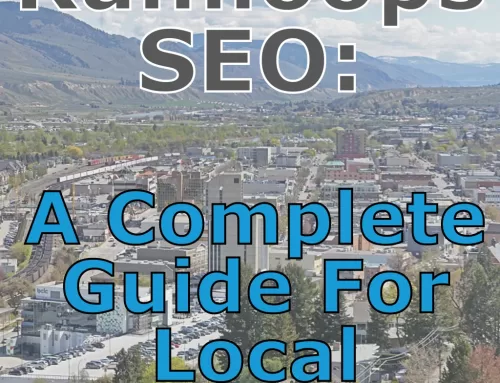In an increasingly digital world, small businesses can no longer rely solely on word-of-mouth or traditional advertising to attract customers. Local SEO, the process of optimizing your online presence to attract more business from relevant local searches, has become a vital tool for small businesses aiming to thrive in their communities.
This article will explore the key elements of local SEO, actionable strategies for optimization, and the tools and techniques to help your small business stand out in your area.
What is Local SEO?
Local SEO is a subset of search engine optimization (SEO) that focuses on optimizing a business’s online presence to rank higher in local search results. For example, searches like “best coffee shop near me” or “plumber in Kelowna” are driven by local intent, meaning the user is looking for services or products in a specific geographic area.
Search engines like Google use various signals, including location data, online reviews, and business directories, to deliver the most relevant results to these searches.
Why is Local SEO Important for Small Businesses?
- Increased Visibility
Local SEO ensures your business appears at the top of search results when potential customers search for services in your area. - More Foot Traffic
Optimized local listings can drive more people to your physical location, especially when paired with strong calls to action. - Targeted Audience
Local SEO focuses on people actively seeking your products or services, leading to higher conversion rates. - Competitive Advantage
Many small businesses neglect local SEO, giving you an edge when you prioritize it. - Mobile Search Growth
With the rise of mobile devices, local searches like “near me” have skyrocketed, making local SEO more critical than ever.
Key Elements of Local SEO
To succeed in local SEO, small businesses must optimize several elements. Let’s break them down:
1. Google Business Profile (GBP) Optimization
Google Business Profile (formerly Google My Business) is the cornerstone of local SEO. This free tool allows businesses to manage their online presence on Google Search and Google Maps.
Steps to Optimize GBP:
- Claim and Verify Your Listing: Ensure you claim and verify your Google Business Profile to access all features.
- Provide Accurate Information: Fill out all sections, including business name, address, phone number (NAP), hours, and services.
- Choose the Right Categories: Select primary and secondary categories that best describe your business.
- Add Photos and Videos: High-quality images of your products, services, and location attract more customers.
- Encourage Reviews: Ask satisfied customers to leave positive reviews, and respond to all reviews promptly.
2. Local Keywords
Using the right keywords is crucial for local SEO success. These should include location-specific terms that match what users in your area search for.
How to Identify Local Keywords:
- Use tools like Google Keyword Planner or SEMrush to find keywords with local intent.
- Combine primary keywords with location terms (e.g., “landscaping services in Kamloops”).
- Focus on long-tail keywords to capture more specific queries.
3. Local Citations and Directories
Local citations are mentions of your business’s NAP on other websites, such as directories, social media platforms, or review sites.
Tips for Effective Local Citations:
- Consistency is Key: Ensure your NAP is identical across all listings to avoid confusion.
- Leverage Reputable Directories: Focus on high-quality, niche-specific directories relevant to your industry.
- Claim Listings on Major Platforms: List your business on Yelp, TripAdvisor, and industry-specific sites.
4. Online Reviews
Online reviews significantly influence consumer decisions and play a role in local search rankings.
How to Manage Reviews Effectively:
- Encourage customers to leave reviews on Google, Yelp, and Facebook.
- Respond to both positive and negative reviews professionally.
- Use negative feedback to improve your services.
5. Localized Content
Creating content that resonates with your local audience helps boost your visibility and engagement.
Ideas for Local Content:
- Write blog posts about community events or issues relevant to your area.
- Highlight customer success stories or case studies from your locality.
- Create location-specific landing pages for each area you serve.
6. Mobile Optimization
Since most local searches are conducted on mobile devices, having a mobile-friendly website is essential.
Tips for Mobile Optimization:
- Use responsive design to ensure your site adapts to different screen sizes.
- Optimize loading speed by compressing images and reducing code.
- Make navigation easy with large buttons and clear menus.
7. Backlinks from Local Sources
Building backlinks from local websites enhances your authority and visibility in local searches.
Strategies for Local Backlinks:
- Partner with local businesses for cross-promotion.
- Sponsor community events or charities and request a link in return.
- Contribute guest posts to local blogs or news sites.
Tools for Local SEO
Several tools can help small businesses improve their local SEO efforts. Here are some must-haves:
- Google Business Profile Manager: For managing your GBP listing.
- BrightLocal: A comprehensive tool for tracking rankings, managing citations, and monitoring reviews.
- SEMrush or Ahrefs: For keyword research and backlink analysis.
- Moz Local: Ensures your business information is consistent across directories.
- Whitespark: Helps find citation opportunities and track local SEO performance.
Common Local SEO Mistakes to Avoid
Even with the best intentions, mistakes can hinder your local SEO efforts. Watch out for these common pitfalls:
- Inconsistent NAP Information: Conflicting details across platforms confuse search engines and customers.
- Ignoring Reviews: Neglecting online reviews can harm your reputation and rankings.
- Keyword Stuffing: Overloading your content with keywords leads to penalties.
- Poor Mobile Experience: A non-responsive site can turn away mobile users.
- Neglecting Analytics: Without tracking performance, you won’t know what’s working or needs improvement.
How to Measure Local SEO Success
To ensure your efforts are paying off, track these key performance indicators (KPIs):
- Local Search Rankings: Use tools like BrightLocal to monitor where you rank for local keywords.
- Website Traffic: Analyze organic traffic using Google Analytics.
- Customer Actions on GBP: Track clicks, calls, and direction requests via your Google Business Profile insights.
- Online Reviews: Monitor the quantity and quality of reviews.
- Conversions: Measure the number of leads or sales resulting from local searches.
Conclusion
Local SEO is a powerful tool for small businesses to attract customers in their area, drive more foot traffic, and establish themselves as trusted local providers. By optimizing your Google Business Profile, targeting local keywords, managing online reviews, and creating localized content, you can improve your visibility and connect with your community.
Start implementing these strategies today to make 2025 your business’s most successful year yet. With a solid local SEO plan, your small business can thrive in an increasingly competitive market.




